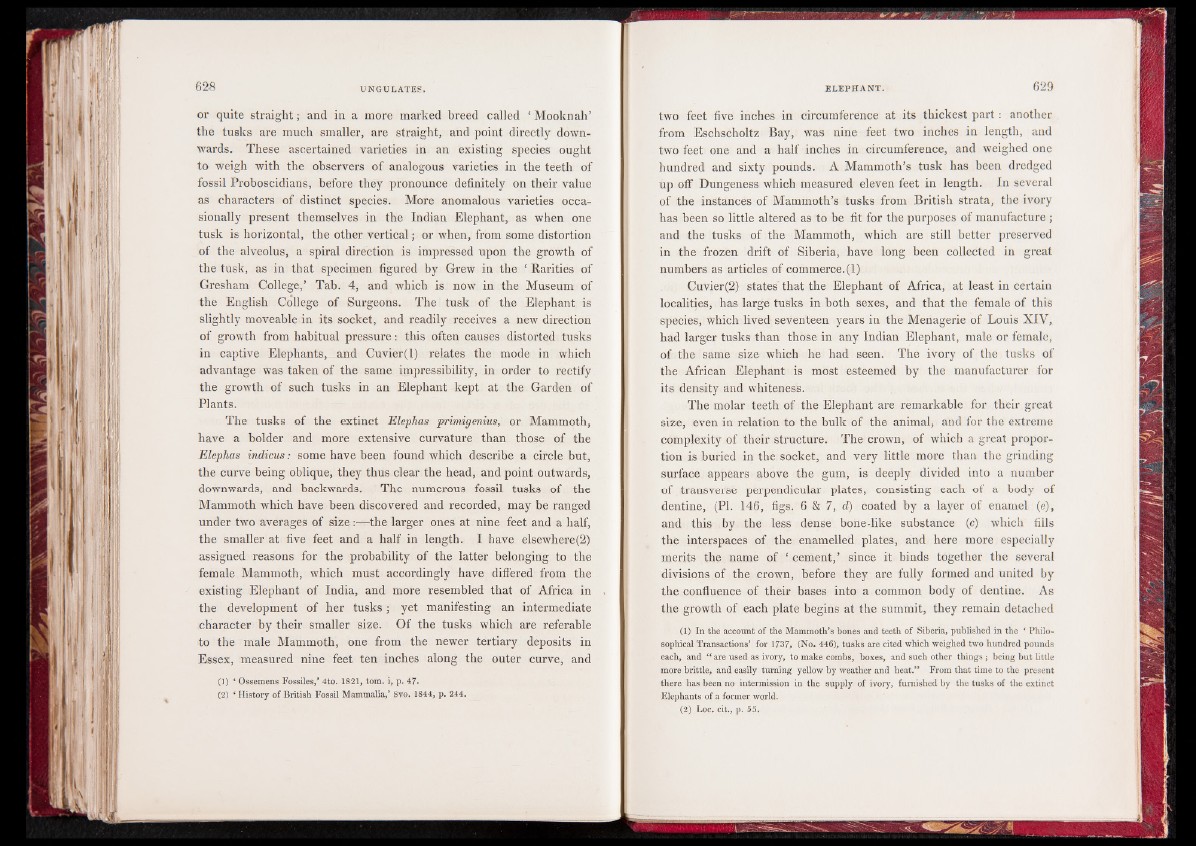
or quite straight; and in a more marked breed called 1 Mooknah’
the tusks are much smaller, are straight, and point directly downwards.
These ascertained varieties in an existing species ought
to weigh with the observers of analogous varieties in the teeth of
fossil Proboscidians, before they pronounce definitely on their value
as characters of distinct species. More anomalous varieties occasionally
present themselves in the Indian Elephant, as when one
tusk is horizontal, the other vertical; or when, from some distortion
of the alveolus, a spiral direction is impressed upon the growth of
the tusk, as in that specimen figured by Grew in the ‘ Rarities of
Gresham College,’ Tab. 4, and which is now in the Museum of
the English College of Surgeons. The tusk of the Elephant is
slightly moveable in its socket, and readily receives a new direction
of growth from habitual pressure: this often causes distorted tusks
in captive Elephants, _and Cuvier(l) relates the mode in which
advantage was taken of the same impressibility, in order to rectify
the growth of such tusks in an Elephant kept at the Garden of
Plants.
The tusks of the extinct Elephas primigenius, or Mammoth,
have a bolder and more extensive curvature than those of the
Elephas indicus: some have been found which describe a circle but,
the curve being oblique, they thus clear the head, and point outwards,
downwards, and backwards. The numerous fossil tusks of the
Mammoth which have been discovered and recorded, may be ranged
under two averages of s i z e t h e larger ones at nine feet and a half,
the smaller at five feet and a half in length. I have elsewhere(2)
assigned reasons for the probability of the latter belonging to the
female Mammoth, which must accordingly have differed from the
existing Elephant of India, and more resembled that of Africa in
the development of her tusks; yet manifesting an intermediate
character by their smaller size. Of the tusks which are referable
to the male Mammoth, one from the newer tertiary deposits in
Essex, measured nine feet ten inches along the outer curve, and
(!) * Ossemens Fossiles,’ 4to. 1821, tom. i, p. 47.
(2) * History of British Fossil Mammalia,5 8vo. 1844, p. 244.
two feet five inches in circumference at its thickest part: another
from Eschscholtz Bay, was nine feet two inches in length, and
two feet one and a half inches in circumference, and weighed one
hundred and sixty pounds. A Mammoth’s tusk has been dredged
up off Dungeness which measured eleven feet in length. In several
of the instances of Mammoth’s tusks from British strata, the ivory
has been so little altered as to be fit for the purposes of manufacture ;
and the tusks of the Mammoth, which are still better preserved
in the frozen drift of Siberia, have long been collected in great
numbers as articles of commerce. (1)
Cuvier(2) states’ that the Elephant of Africa, at least in certain
localities, has large tusks in both sexes, and that the female of this
species, which lived seventeen years in the Menagerie of Louis XIY,
had larger tusks than those in any Indian Elephant, male or female,
of the same size which he had seen. The ivory of the tusks of
the African Elephant is most esteemed by the manufacturer for
its density and whiteness.
The molar teeth of the Elephant are remarkable for their great
size, even in relation to the bulk of the animal, and for the extreme
complexity of their structure. The crown, of which a great proportion
is buried in the socket, and very little more than the grinding
surface appears above the gum, is deeply divided into a number
of transverse perpendicular plates, consisting each of a body of
dentine, (PL 146, figs. 6 & 7, d) coated by a layer of enamel (e),
and this by the less dense bone-like substance (c) which fills
the interspaces of the enamelled plates, and here more especially
merits the name of ‘ cement,’ since it binds together the several
divisions of the crown, before they are fully formed and united by
the confluence of their bases into a common body of dentine. As
the growth of each plate begins at the summit, they remain detached
(1) In the account of the Mammoth’s bones and teeth of Siberia, published in the * Philosophical
Transactions’ for 1737, (No. 446), tusks are cited which weighed two hundred pounds
each, and “ are used as ivory, to make combs, boxes, and such other things ; being but little
more brittle, and easily turning yellow by weather and heat.” From that time to the present
there has been no intermission in the supply of ivory, furnished by the tusks of the extinct
Elephants of a former world.
(2) Loc. cit., p. 55.